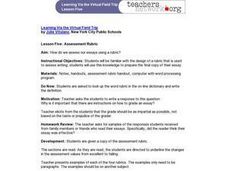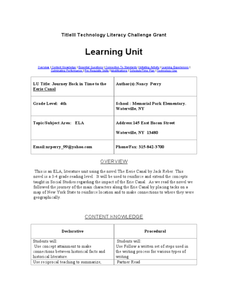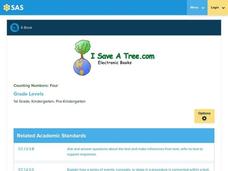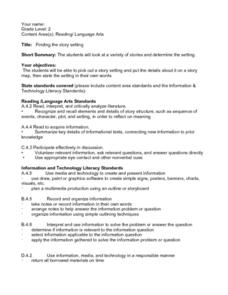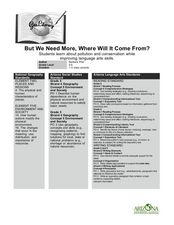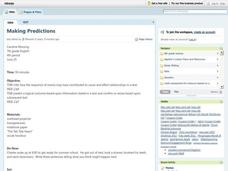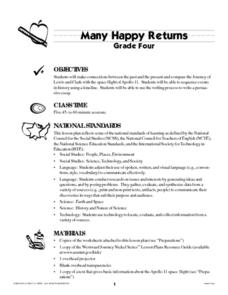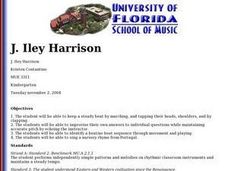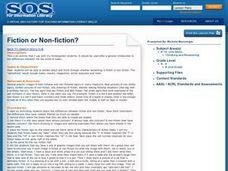Curated OER
Death On Board La Belle: Finding Clues from Old Bones
Learners practice analyzing skeletal remains for clues by using the Internet. In this scientific investigation lesson plan, students research the La Belle shipwreck using the Internet and written materials, later completing a...
Curated OER
Ramona Quimby, Age 8
Third graders read Beverly Cleary's book "Ramona Quimby, Age 8" and then complete a series of extension activities. Students explore cause and effect, sequencing, related websites, grammar lessons and comparison skills.
Curated OER
Assessment Rubric
Middle schoolers complete their activities related to writing persuasive essays. As a class, they review the components and structure of a rubric. They use this information to write their final essay on educational opportunities at...
Curated OER
Erie Canal: Journey Back in Time
Fourth graders read the novel, The Eric Canal, identifying the characters and setting. They respond to daily reading by writing in journals and complete a short answer test upon completion of the novel.
Channel Islands Film
Arlington Springs Man: Lesson Plan 1
Learning to craft quality questions is a skill that can be taught. Class members use the Question Formulation Technique to learn how to create and refine both closed-ended and open-ended questions. They then view West of the West's...
California Department of Education
Possible Careers
Is a STEM career the right choice for me? Lesson four in a six-part career and college readiness series introduces seventh graders to the world of STEM occupations. Individuals use their Holland code results to select, research, and...
Voice of America
Henry Ford, 1863-1947: He Revolutionized the Auto Industry
How did Henry Ford change the world? One word: automobile. After reading a two-page passage about Henry Ford's contributions to society with the invention of the automobile, readers respond to a series of 10 reading comprehension...
Pennsylvania Department of Education
Counting Numbers: Four
Students practice counting to four. In this counting to four lesson, students access an e-book at "I Save A Tree.com" where they count items up to four. They examine the text and images which can be seen in both Spanish and English.
Curated OER
How the West Was One: A Layered Book
Students create a layered book about the information they learn about the Western region of the United States. In this Western states lesson plan, students create a book about the land, economy, and culture.
Alabama Learning Exchange
Pat Brisson's Benny's Pennies
Learners listen to the book, "Benny's Pennies" and conduct math and language arts lessons to go along with the book. They demonstrate their ability to count pennies, understand proper sequence, and rewrite a story using different...
Curated OER
An Exploration of Automotive Design
students research varied aspects of car design, and create a new design for the exterior body of a car. Students conduct Internet research, respond to writing prompts, and analyze, evaluate and synthesize information from multiple...
Curated OER
Finding the Story Setting
Second graders discuss important things to know when reading stories, identify setting in variety of stories, create story map to record information as they are reading, state setting in their own words, discuss whether they thought...
Curated OER
The Very Hungry Caterpillar - Collage Technique
First graders listen to the story The Hungry Caterpillar, then sequentially organize their own re-writing and re-creating of the story. They construct illustrations for their book using the collage technique Eric Carle used in his...
Curated OER
Plant Parts with Sequencing Cube
Third graders listen to the story, Jack's Garden by Henry Cole. They learn the parts of the plant by looking at live plants.
Curated OER
But We Need More, Where Will It Come From?
Students write a persuasive letter and create a poster about pollution and conservation. In this pollution and conservation lesson plan, students learn how humans are the number 1 cause of pollution.
Curated OER
Making Predictions
Seventh graders read stories, stopping periodically to make predictions. They discuss how the sequence of events, as well as cause and effect, can give hints to the outcome of the story. In addition, 7th graders use logic and...
Curated OER
Plot Structure
Ninth graders review the parts of a plot sequence for a short story. They think of a famous Disney movie and plot the events of the movie in the correct plot sequence. They do the same for a comic strip, labeling the exposition, rising...
Alabama Learning Exchange
Landforms Acrostic Poetry
Fourth graders apply scientific information about various landforms. They use the information to write and word process acrostic poems which they illustrate with clip art or pictures from magazines.
Curated OER
Many Happy Returns
Students compare the journey of Lewis and Clark with the space flight of Apollo 11. Students sequence events using a timeline. Students write a persuasive essay trying to persuade the people of the US to support space exploration.
Curated OER
Reviewing Main Events in Fiction
Students analyze elements of fiction while reading. In this reading analysis lesson, students read specific texts and retell the information they remember. Students discover how sequential storytelling works.
Curated OER
Biochemical Cycles: Recycling Carbon and Nitrogen
Students construct flow diagrams of the carbon and nitrogen cycle processes. They identify sequences in each cycle that are affected by human impact and present their research to the class.
Curated OER
Beat Or No Beat
Students keep a steady beat by body movement exercises, improvise, identify a beat/no beat sequence and sing a nursery rhyme from Portugal in this Kindergarten General Music lesson. The use of simple rhythmic instruments is required.
Curated OER
Black History Month
Students work in cooperative pairs to research information and give oral presentations about African American men and women who have made significant contributions to U.S. history.
Curated OER
Fiction or Non-fiction
Third graders view three texts, A DAY IN THE LIFE OF A FOOTBALLER, THE HUMAN BODY, AND WHICH IS WHICH? with the titles covered. They discuss whether the books are non-fiction or fiction and try to come up with suitable titles for the books.


